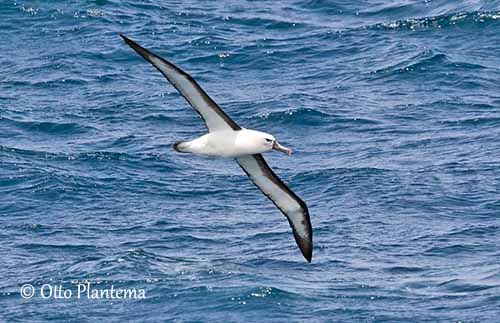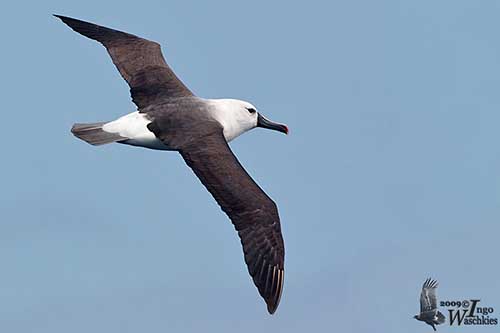
Fr : Albatros de l’Océan Indien - Albatros de Carter
Ang : Indian Yellow-nosed Albatross
All : Kerguelen-Gelbnasenalbatros
Esp : Albatros clororrinco pacífico
Nd : Indische Geelneusalbatros
Sd : gulnäbbad albatross
Photographers:
Otto Plantema
Trips around the world
Simon Tan
PBase Bird galleries
Ingo Waschkies
Bird Photography
Text de Nicole Bouglouan
Sources:
HANDBOOK OF THE BIRDS OF THE WORLD vol 1 by Josep del Hoyo-Andrew Elliot-Jordi Sargatal - Lynx Edicions - ISBN: 8487334105
A Complete Guide to Antarctic Wildlife by Hadoram Shirihai and Illustrated by Brett Jarrett - Edited by Guy M. Kirwan - ALUL.A Press Oy, Finland - ISBN 9519894705
BirdLife International (BirdLife International)
Department of Sustainability, Environment, Water, Population and Communities
Wikipedia, the free encyclopaedia
Biodiversity Explorer – The Web of Life in Southern Africa
Page family Diomedeidae
Summary cards
Indian Yellow-nosed Albatross
Thalassarche carteri
Procellariiformes Order – Diomedeidea Family
INTRODUCTION:
The Indian Yellow-nosed Albatross was formerly a subspecies of the Atlantic Yellow-nosed Albatross. It was listed as race Thalassarche chlororhynchos bassi, whereas T.c. carteri was considered similar to the nominate race T.c. chlororhynchos. But following examination and molecular studies of specimens, “bassi” and “carteri” are finally referable to the same taxon.
This species is Endangered and the population is declining due to avian diseases and interaction with longline fisheries and fishing boats.
DESCRIPTION OF THE BIRD:
Biometrics:
Length: 71-81 cm
Wingspan: 180-215 cm
Weight: 2490-2930 g
The Indian Yellow-nosed Albatross is one of the smallest albatrosses. It has whitish-grey head and nape. Mantle, upperwing and tail are dark grey. Rump and underparts are white. The underwing is white with black tip, conspicuous black leading edge and narrow black trailing edge. The undertail-coverts are white but the undertail is blackish.

We can see a small dark patch before the eye. The bill is black with yellow upper ridge becoming orange at tip. The eyes are dark brown. Legs and webbed feet are dark grey with pale pink webs.
Male and female are similar.
The juvenile resembles adult, but it has white head and entirely black bill.
RANGE:
The Indian Yellow-nosed Albatross is found in S Indian Ocean. It breeds on Prince Edward Island, and also on Crozet, Kerguelen, Amsterdam and St Paul Islands.
Outside the breeding season, it disperses in Southern Ocean and can be abundant off S and E coasts of South Africa. It can reach Australia and New Zealand too.
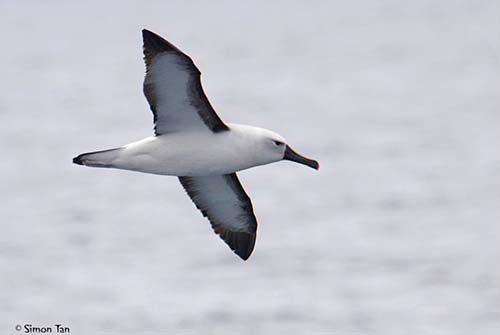
HABITAT:
The Indian Yellow-nosed Albatross is marine and pelagic. It breeds on slopes and cliffs on remote islands, usually in rocky areas with tall grasses, but often on bare ground.
At sea, it occurs over the continental shelves where it finds abundant food sources.
CALLS AND SONGS: SOUNDS BY XENO-CANTO
The Indian Yellow-nosed Albatross’s voice resembles that of the Atlantic Yellow-nosed Albatross. It produces high-pitched clattering cry (or braying). At sea, they give noisy croaks during squabbles around food.
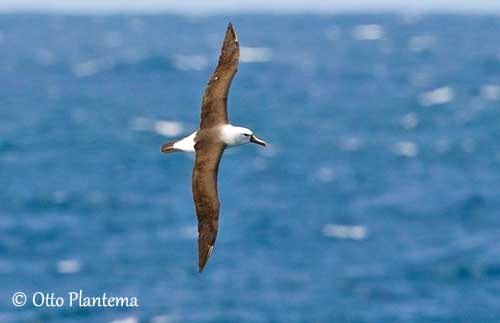
BEHAVIOUR IN THE WILD:
The Indian Yellow-nosed Albatross feeds on fish but mostly on cephalopods. It also takes crustaceans and sometimes offal.
It feeds mainly by surface-seizing, but also by diving. It performs shallow plunges and may pursue a prey until 1 metre deep. It uses its wings to propel itself underwater.
It can be seen fishing with other species such as cetaceans and the Australasian Gannet. It may follow fishing boats and often snatches the food and flies away to consume it alone. It is solitary or gregarious, depending on the situation.
The Indian Yellow-nosed Albatross is monogamous and the pair has long-term pair-bonds. Like other Diomedeidae species, it nests singly or in loose groups, but also in dense colonies. The courtship displays include aerial activities, croaking noises, bill-kissing, bill-clashing, bowing and mutual preening.
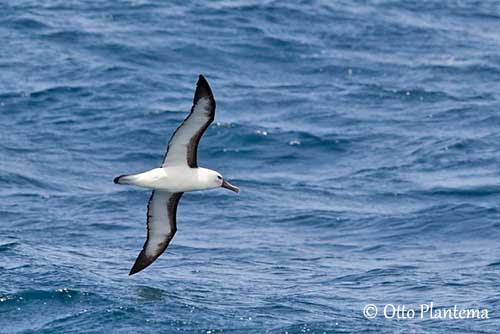
The Indian Yellow-nosed Albatross disperses in the Southern Ocean after the breeding season, reaching the S and E coasts of South Africa, Australia, as far east as the Tasman Sea and NE New Zealand waters.
It flies and glides on stiff wings, rising and falling, and taking advantage of the wind speeds at different heights.
Take-off and landing are often difficult manoeuvres, but the bird is powerful.
REPRODUCTION OF THIS SPECIES:
The Indian Yellow-nosed Albatross breeds annually from mid-September/early October to late March/early April.
The bird return in September to the colony, but it may nest solitary or in loose groups. However, densities are higher on flatter areas.
They nest on rocky cliffs in tussock grass or on bare ground, in depressions or ravines among grasses, or under scrub in more open areas. The large nest is a cylindrical cone made with grass and mud, of about 30-60 centimetres high.
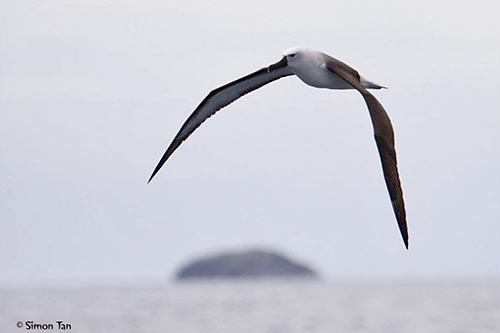
The female lays a single whitish egg with small brown spots. Both adults incubate during 70-72 days and take turns regularly.
At hatching, the chick has pale grey to whitish down. It is brooded during the first three weeks. The adults perform foraging trips lasting 2/4 days, sometimes more according to the location.
The young fledges 115-130 days after hatching, in March/April. It can breed at 9 years.
PROTECTION / THREATS / STATUS:
The Indian Yellow-nosed Albatross is listed as Endangered, based on rapid decline of the population.
The adults are drowned and killed in commercial longline fisheries, and are affected by avian diseases.
The global population is estimated at 41,580 pairs, equating to 83,160 mature individuals, and perhaps more than 160,000 individuals in total.
Some longline fishing vessels start to employ a range of mitigation measures. Population monitoring and studies are undertaken at Amsterdam Island, and the Prince Edward Islands are a Special Nature Reserve.
The Indian Yellow-nosed Albatross is currently listed as Endangered.
